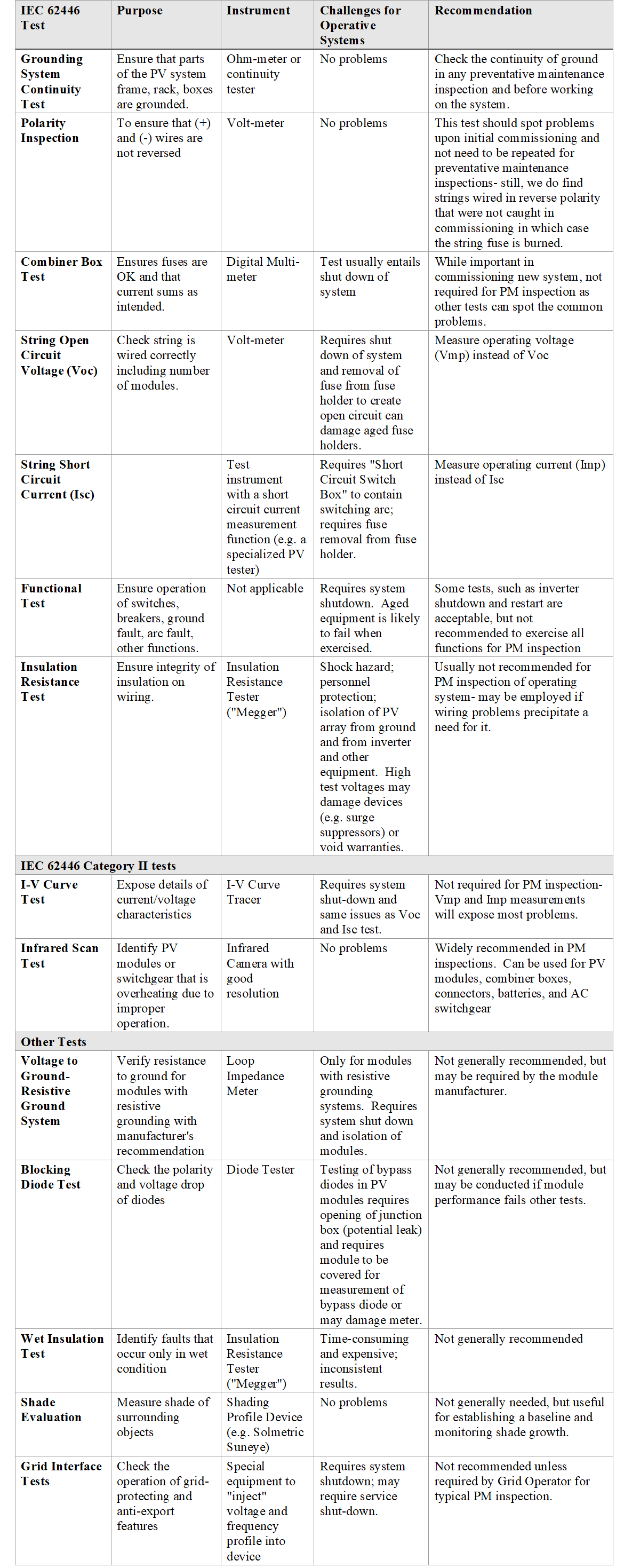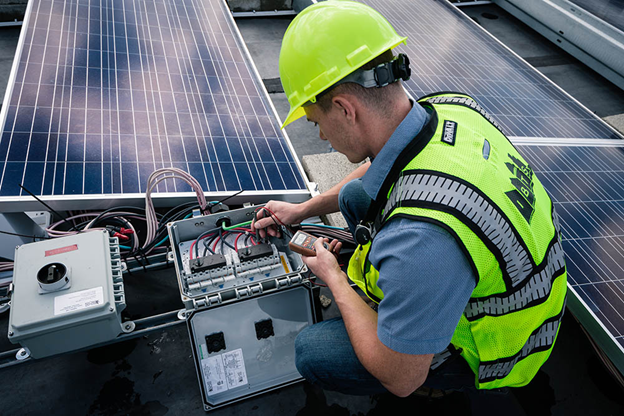IEC standards set by the International Electrotechnical Commission are a valuable reference point for ensuring consistency and are commonly used in new construction projects where the circuits to be tested are accessible and have not yet been energized.
However, when it comes to the Operations & Maintenance of existing and up-and-running systems, blindly following these standards without considering the specific context of the work can be counterproductive. In some cases, performing electrical tests as described in the standard can even result in system damage and pose a safety risk to personnel. Therefore, it is crucial for solar deployment teams to translate these standards into actionable procedures that take into account real-world considerations.
IEC 62446-1 (see the table at the end of the article) establishes the standard for testing, documenting, and maintaining grid-connected PV systems. The standard specifically outlines protocols for direct current (DC) testing, which is used to assess the health of the system at various points of asset life.
In order to make these standards more actionable, the Department of Energy has funded a collaborative research initiative between solar software provider illu and the National Renewable Energy Lab (NREL). The program aims to adapt NREL’s published best practices guidance for solar PV O&M into digital, operational, and publicly accessible procedures.
Initially, the guidelines were in the form of lengthy PDF documents, which made them challenging to use on-site. The team has now converted them into digital and interactive flows, specifically designed for mobile devices. These resources are now publicly accessible and free-of-charge in illu’s Workflow Library.
In addition, IEC standards are utilized in a range of situations throughout the lifecycle of a system. These may involve equipment in different physical states and be performed for varying objectives. To meet the specific objectives of each use case more effectively, the team developed case-specific applications of the IEC standards.
Adapting procedures for each use case
Practically speaking, PV system testing and inspections are conducted in three situations: commissioning, preventative maintenance and recommissioning. In each of these cases, the system may vary significantly in terms of age, physical condition and operational status. The primary objective of the activity would also differ depending on the situation.
During the commissioning process, the objective is to confirm that the system is fully constructed, aligns with the designs and contract terms, and is ready for handover and operation. In this context, conducting a thorough and meticulous evaluation of the system is ideal. Comprehensive inspections and testing are carried out to identify any issues or defects prior to the Commercial Operation Date (COD), in order to prevent problems from arising after the contractual handover, when it may be too late to address them. This process also helps to eliminate any workmanship issues and identify any faults from the manufacturer.
Therefore, all tests within the IEC standard apply if the appropriate equipment and PPE are available. Since the system is not yet energized, testers can take open circuit measurements and perform tests that would otherwise require taking the system out of operation.
Commissioning testing workflow
In preventative maintenance (PM), the objective is to ensure adequate performance while avoiding disruptions that may take a system out of normal operations. Unlike commissioning, PM is not associated with a one-time handover and can be revisited if situations change. PM is often performed on older systems, and putting stress on fuse holders and connectors may increase the likelihood of failure.
A less intrusive protocol is typically sufficient, and the team has provided two tiers of testing based on intrusiveness. The first option relies solely on visual inspections and an overall system performance evaluation.
The second option adds a moderate level of testing, including Vmp and string-level Imp. This allows testers to adequately evaluate if there are any abnormalities that need further investigation, without disturbing stable operations (which would occur when performing open circuit tests).
Preventative maintenance testing workflow
Specific practical adjustments
Beyond adapting standards to the objectives in each use case, there are other site-specific considerations that impact the tasks to include in your processes.
Available Equipment. Two tests depend on specialized equipment and may not be practical for many solar teams:
- Short circuit current test: Performing a short circuit voltage test using basic meters can result in large arc flashes, heat-damaged meters, and unnecessary safety risk to personnel. It can be safely performed with specific meters, such as the Fluke PV tester, but these can be prohibitively expensive for smaller teams and may not be practical.
- Bypass diode test: Devices specifically made for testing bypass diode failure are expensive, making it impractical for some teams to use.
System Age/Condition: Systems that are older or have faced more significant degradation (such as humidity, salt mist corrosion) require consideration for their physical state, making it impractical to perform certain functional tests:
- Breaker functional tests: The standard includes functional testing the operation of breakers and relay switches. Adding stress through repeated exercising of mechanical components can increase the likelihood of failure or directly result in component failure.
- Short circuit current and open circuit voltage tests: Similarly, opening and closing of the fuse to isolate the system to perform open circuit testing can put stress on the system and damage an older fuse holder, impacting overall system operation. These tests are essential during commissioning but can be replaced with measurements of operating current and voltage during preventive maintenance (PM) checks.
Hitting the right balance
The illu and NREL team conducted a thorough comparison between generic inspection and testing checklists based on IEC 62446-1, and context-specific Standard Operating Procedures (SOPs) developed through illu Workflows. In collaboration with Solar Energy International, the team tested and refined processes that strike the right balance between incorporating key IEC-recommended considerations and practicality for teams on the ground.
The following processes were specifically designed for ground-mounted PV arrays:
- Commissioning String-level Testing
- Preventative Maintenance String-level Testing
- System Performance Inspection
These processes can be edited and adjusted to suit the requirements of your sites using illu’s Workflow editor.

 Natasha Allen is co-founder of illu, a purpose-built software start-up that provides a central command center for workflow management and field communications in order to bring energy access to the 800 million people globally living without reliable electricity.
Natasha Allen is co-founder of illu, a purpose-built software start-up that provides a central command center for workflow management and field communications in order to bring energy access to the 800 million people globally living without reliable electricity.
The views and opinions expressed in this article are the author’s own, and do not necessarily reflect those held by pv magazine.
This content is protected by copyright and may not be reused. If you want to cooperate with us and would like to reuse some of our content, please contact: editors@pv-magazine.com.








By submitting this form you agree to pv magazine using your data for the purposes of publishing your comment.
Your personal data will only be disclosed or otherwise transmitted to third parties for the purposes of spam filtering or if this is necessary for technical maintenance of the website. Any other transfer to third parties will not take place unless this is justified on the basis of applicable data protection regulations or if pv magazine is legally obliged to do so.
You may revoke this consent at any time with effect for the future, in which case your personal data will be deleted immediately. Otherwise, your data will be deleted if pv magazine has processed your request or the purpose of data storage is fulfilled.
Further information on data privacy can be found in our Data Protection Policy.